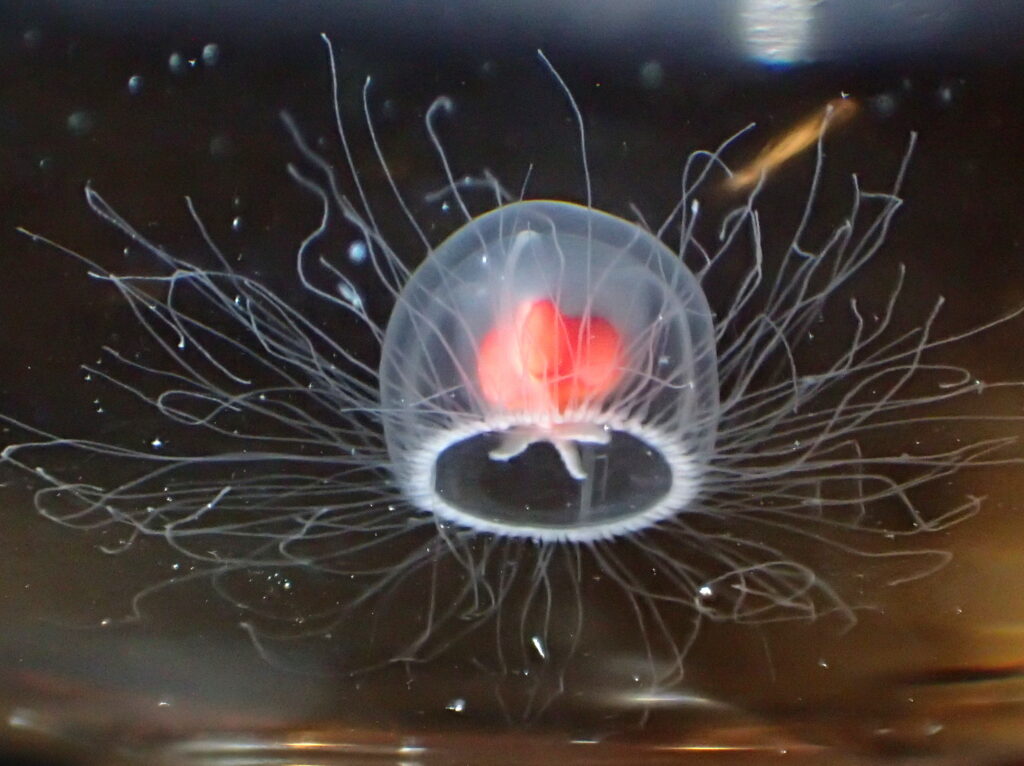What Is the Immortal Jellyfish
The Immortal Jellyfish, scientifically known as Turritopsis dohrnii, is a small species of jellyfish found primarily in the Mediterranean Sea and around Japan. It measures only about 4 to 5 millimeters in diameter, yet it holds one of nature’s most extraordinary secrets.
This tiny marine creature has the unique ability to reverse its aging process, effectively returning to a younger state instead of dying, which is why it is often called “immortal.”

The Science Behind Its Immortality
Like other jellyfish, Turritopsis dohrnii begins life as a larva known as a planula. The larva attaches itself to a surface and develops into a colony of polyps. These polyps then produce free-swimming medusas, which we recognize as adult jellyfish.
ALSO SEE : Brainless but Smart Creature: The Amazing Intelligence of Slime Mold
When most jellyfish reach the end of their lifespan, they die. However, the Immortal Jellyfish has a remarkable trick. When it is injured, starving, or under stress, it can revert from its adult form back to the polyp stage. This process is called transdifferentiation, where its cells transform into new types of cells, regenerating tissues and restarting its life cycle.
In theory, this cycle can repeat indefinitely, making Turritopsis dohrnii biologically immortal. In practice, most individuals are eaten by predators or die from disease before they can live forever, but the process itself shows an incredible adaptation.
Where It Is Found
The Immortal Jellyfish was first discovered in the Mediterranean Sea but has since spread across the world’s oceans. It is believed that global shipping routes have helped distribute it to new environments.
It thrives in warm and temperate waters, often in coastal regions, where it feeds on plankton and other tiny sea organisms.
Why Scientists Study the Immortal Jellyfish
The ability of Turritopsis dohrnii to reverse aging has captured the attention of scientists studying regenerative medicine and cellular biology. By understanding how its cells transform and renew themselves, researchers hope to unlock clues that could lead to medical breakthroughs for humans.
Studying the jellyfish may also help scientists learn more about aging, cancer, and the regeneration of damaged tissues.
However, the jellyfish’s cellular processes are extremely complex, and it may take decades before these mechanisms can be fully understood or applied to other species.
Fascinating Facts About the Immortal Jellyfish
- It is smaller than a fingernail but capable of an infinite life cycle under ideal conditions.
- The process of reverting to a polyp can happen multiple times throughout its life.
- It reproduces both sexually and asexually.
- It has no brain, heart, or bones, yet its regenerative power is unmatched.
- Its discovery in the 1990s revolutionized the scientific understanding of aging in marine life.
Conservation and Environmental Role
The Immortal Jellyfish is not currently endangered, but like many marine species, it faces threats from pollution, climate change, and habitat destruction.
Although it is famous for its potential immortality, it still depends on a healthy ocean ecosystem to survive. Protecting coral reefs, reducing plastic waste, and preserving marine habitats are crucial for the balance of ocean life, including this fascinating jellyfish.
The Immortal Jellyfish is one of nature’s most mysterious and inspiring creatures. Its ability to reset its life cycle challenges what we know about aging and death.
Though it may not truly live forever in the wild, the biological processes behind its regeneration continue to intrigue scientists and spark new possibilities for medical research.
Tiny but powerful, the Immortal Jellyfish reminds us that nature still holds many secrets waiting to be uncovered.
ALSO SEE : How Clouds Form: Understanding the Science Behind the Sky





